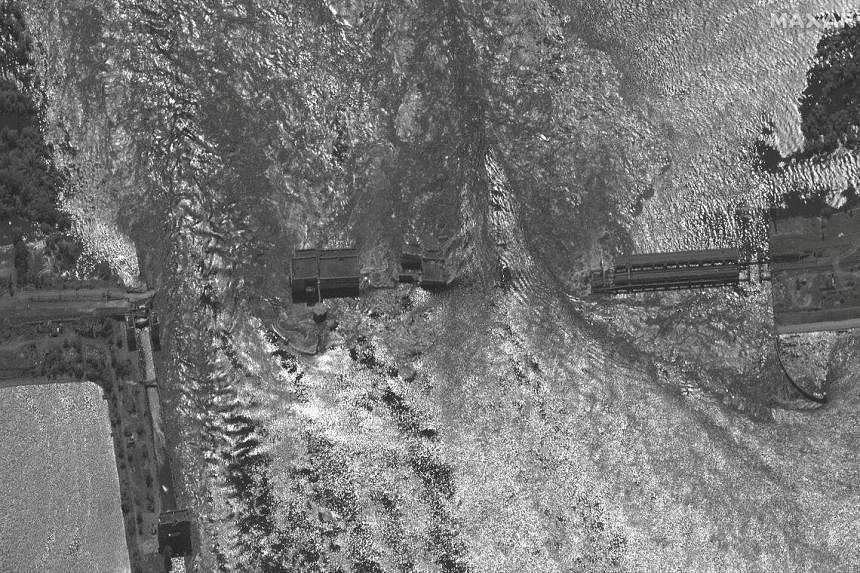
KHERSON, Ukraine - The destruction of the Kakhovka dam will flood tens of thousands of hectares of agricultural land in southern Ukraine and could turn at least 500,000 ha of land left without irrigation into “deserts”, the agriculture ministry said.
The dam on the Dnipro River was destroyed on Tuesday, flooding a swathe of the front line in the Kherson region, forcing villagers to flee.
Ukraine, a major global producer and exporter of grain, has accused Moscow of committing a war crime by blowing up the Soviet-era dam, which powered a hydroelectric station and was occupied by Russia.
The Kremlin blames the collapse on Ukraine.
Some independent experts say the dam may have collapsed due to earlier damage and intense pressure on it.
Kyiv has estimated that about 42,000 people are at risk from flooding that it expects to peak on Wednesday.
Ukrainian President Volodymyr Zelensky said the dam’s collapse had left hundreds of thousands of people without normal access to drinking water.
“The destruction of the Kakhovka hydroelectric power station will lead to the fact that fields in the south of Ukraine may turn into deserts next year,” the agriculture ministry said.
It said in a statement late issued late on Tuesday that the disaster would cut off water supply to 31 irrigation systems in the Ukrainian regions of Dnipro, Kherson and Zaporizhzhia.
The ministry said that in 2021 – before Russia’s full-scale invasion – these systems provided irrigation on 584,000 ha from which farmers harvested about 4 million tonnes of grains and oilseeds.
The dam’s destruction has left 94 per cent of irrigation systems in Kherson, 74 per cent of those in Zaporizhzhia and 30 per cent of those in Dnipro regions without water, it said.
The ministry also quoted preliminary estimates indicating that around 10,000 ha of agricultural land on the right bank of the Kherson region would be flooded.
“Several times more (land will be under water) on the left bank of the region, which is currently under occupation,” the ministry said.
The ministry has not said how much grain could be lost because of flooding.
Ukrainian farm minister Mykola Solsky told Reuters last week the country could harvest 18 million tonnes of winter grains this year and winter wheat dominates the output.
A state of emergency was imposed on Wednesday in the Russian-controlled parts of Kherson following the dam’s destruction, Russia’s TASS news agency reported.
Citing emergency services, the agency said about 2,700 houses were flooded after the dam was destroyed.
At least seven people were missing, Moscow-backed officials said.
The Kakhovka dam is located on the front line of the conflict.
Kyiv said the destruction of the dam – seized by Russia in the early hours of the war – was an attempt by Moscow to hamper its long-awaited offensive, which Ukraine’s leader stressed would not be affected.
On its part, Russia said Ukraine was trying to distract from the launch of a major counteroffensive Moscow says is faltering.
Kherson is the largest population centre near the dam. On Tuesday, the area’s residents headed for higher ground as water poured into the Dnipro River.
The city, which was the scene of heavy fighting in 2022, is about 60km downstream from the dam, and water levels rose by 3.5m on Tuesday.
“There is shooting, now there is flooding,” said Ms Lyudmyla, who had loaded a washing machine onto a cart attached to an old Soviet car.
“Everything is submerged in water, all the furniture, the fridge, food, all flowers, everything is floating. I do not know what to do,” Ms Oskana, 53, said when asked about her house.
No deaths have been reported so far, but White House National Security Council spokesman John Kirby said the flooding had probably caused “many deaths”.
UN aid chief Martin Griffiths told the Security Council that the dam breach “will have grave and far-reaching consequences for thousands of people in southern Ukraine on both sides of the front line through the loss of homes, food, safe water and livelihoods”.
“The sheer magnitude of the catastrophe will only become fully realised in the coming days,” he said.
Satellite images taken on Tuesday afternoon by Maxar Technologies of more than 2,500 sq km between Nova Kakhovka and the Dniprovska Gulf, south-west of Kherson city on the Black Sea, showed numerous towns and villages submerged.
The Russian-installed administration of the city of Nova Kakhovka on the Russian-controlled bank of the Dnipro said the water levels started to decline on Wednesday morning.
“The water level on the previously flooded streets of Nova Kakhovka began to subside,” the administration said on the Telegram messaging app.
Residents earlier told Reuters that some had decided to stay despite being ordered out.
“They say they are ready to shoot without warning,” said one man, Hlib, describing encounters with Russian troops.
The Kazkova Dibrova zoo on the Russian-held riverbank was completely flooded and all 300 animals were dead, a representative said via the zoo’s Facebook account.
‘War crime’
President Zelensky urged the world to “react” as he accused Russia of blowing up the dam and said the authorities expected up to 80 settlements to be flooded.
“This crime carries enormous threats and will have dire consequences for people’s lives and the environment,” he told a Vatican peace envoy, Italian cardinal Matteo Zuppi, in Kyiv, the presidency said.
He later said in a Telegram message that the explosion “did not affect Ukraine’s ability to de-occupy its own territories”.
https://news.google.com/rss/articles/CBMiaGh0dHBzOi8vd3d3LnN0cmFpdHN0aW1lcy5jb20vd29ybGQvZXVyb3BlL3VrcmFpbmUtZXZhY3VhdGVzLW92ZXItMTcwMDAtcGVvcGxlLWFmdGVyLWtleS1kYW0taXMtZGVzdHJveWVk0gEA?oc=5
2023-06-07 08:43:39Z
2109640738
Tidak ada komentar:
Posting Komentar